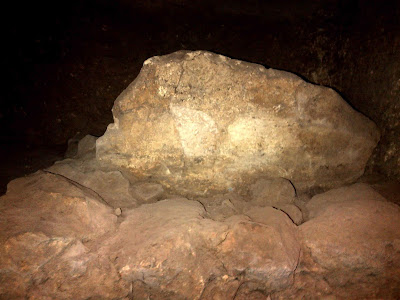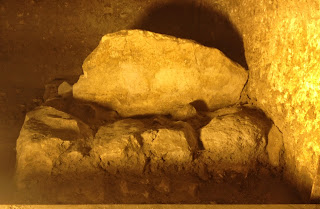 |
| Covenant of Jacob - Standing Stone or Matzevah at Beit El, Bethel, Ancient Jerusalem |
For 39 years the progenitor Israel lived with a gnawing frustration because the covenant he, as Jacob made at Beit El to build the House of God had not been fulfilled. Confounding events had distracted him from meeting his obligation. After a successful 20 year exile he returned to his homeland to fulfill his covenant, but was delayed by the burden of his cattle, the idols his entourage carried, the rape of his daughter and massacre in revenge, the death of his mother, the death of his favored wife, the sale of his favored son Joseph into slavery, by his brothers and their living lie to Jacob.
Ultimately his family’s exile to Egypt, where they were finally reunified with Joseph must have been a bittersweet 17 year end to Jacob’s life. On his deathbed, he struggled to express the vision of his yet unfulfilled covenant, perhaps still hoping to motivate his children to fulfill it. Instead Jacob died hearing their acknowledgement that they too would unify their Creator and with that he bestowed his final blessings to them.
When you make a covenant with your one and only God, there is no escaping it. There is no other god who can cancel or adjust it, that constitution is expressed in the continuity of Jewish law. Jacob memorialized his covenant by setting and anointing a standing stone in Luz, which he renamed Beit El, that marked the place of his obligation. By his default, to build the House of God his unfulfilled covenant became the cornerstone of his nations indigenous memory.
The essential backstory to Jacobs yet unfulfilled covenant is less well known. Before his final exile to Egypt he gathered Acacia seeds, some say the Acacia trees that had originally been planted by Abraham and Jacob south of Jacob’s standing stone at Beit El. Nurturing these trees was Jacob’s contemplation, to provide the wood to construct and fulfill his covenant at the place Malchi-tzedek - High Priest of Salem had practiced, Abraham had offered his son Isaac as a sacrifice and Jacob had set his standing stone on Jerusalem’s Mount Moriah. When Jacob left the land of his inheritance, he took the Acacia seeds with him and, not to give up on his indigenous dream he planted them when they settled in Egypt.
210 years after Jacob’s exile his disenfranchised nation were thrust out of Egypt. Before departing some realized the contemplation of their forefather Jacob was about to come true. Tantalizingly, they anticipated returning to Mount Moriah, they felled the trees prepared the wood and took it from Egypt to be used to complete Jacob’s covenant and vision. But, Israel’s circuitous route back to their land took 40 more years. Along the journey Jacob’s trees were used to construct a temporary sanctuary to house the Ark of the Holy Covenant and offer sacrifices. The sanctuary was deconstructed and reconstructed at 42 locations before the nation was ready to arrive.
The seeds Jacob took with him did not merely provide wood, they also implanted a will, in the national psyche that had taken root with his family to fulfill his covenant. When they carried the wood out of Egypt into the desert to worship The God that had saved them from tyrant Pharaohs they were sentimentally expressing Jacobs Beit El contemplation. But, when Joshua finally led each of the tribes into battle to conquer their allotted land, there were two places he was unable to dislodge the occupant enemy. One was the territory of modern Gaza, which is the territory of Dan and the other Mount Moriah, which straddles territory on the southern boundary of Benjamin and northern boundary of Judah. Emorites and Jebusites had constructed massive fortifications on the eastern slope of Mount Moriah that concealed the bedrock, which in light of recent archaeology is Jacob’s Beit El to hide features of the earliest temple Israel’s ancestors had once developed and used.
It took another 300 years before King David mustered a small force that penetrated the fortification by scaling the water channel flowing out of the Gihon Spring and a bedrock fissure. The young Kings forces successfully occupied the lower section of Mount Moriah, but did not dislodge previous occupants of the mountain including the Jebusite King. King David recovered the Ark of the Holy Covenant that had been stolen by the Philistines of Gaza, but abandoned by them because of their superstitions. He temporarily housed it on the mountain until a permanent temple could be built. Progressively King David established Mount Moriah as his base for unifying the administration of justice over all Israel’s tribes.
During his tenure, the King struggled to find the Mount Moriah site that was destined for the altar of the permanent temple. The exact location was not obvious, but the prerequisite, by Jewish law had to be akeida - the site of the binding of Isaac. Despite all of his efforts, he was unable to locate it. Toward the end of his life, under political pressure for his moral ineptitude he dispatched his loyal general on an ill fated census of the nation. A plague ravaged the nations north killing 70,000, as it approached Jerusalem the King witnessed the angel of death standing on Mount Moriah with its sword drawn over the lower slope, which was Jerusalem at that time. The nations prophet declared the site suitable for an altar. King David who publicly sought forgiveness and the tribal leaders whose tribes were being ravaged, purchased the site from the Jebusite King. King David brought his sacrifices and the plague stopped. The event that unified the tribes was soon forgotten, but the location of the Kings altar was not. Finally King David’s blueprint, for the construction of Jerusalem’s first permanent temple were completed and made ready for his son King Solomon to construct.
Notwithstanding the joyful pomp and ceremony at the inauguration of Jerusalem’s first permanent temple, Jacob’s Beit El location had been lost. It was inadvertently re-discovered by King Hezekiah’s builders during his Gihon Spring tunnel reconstruction, but it was quickly and perfectly re-buried and preserved. It was rediscovered by Eli Shukron, in the City of David on the eastern slope of Mount Moriah 3533 after Jacob’s exile in 2010.



















